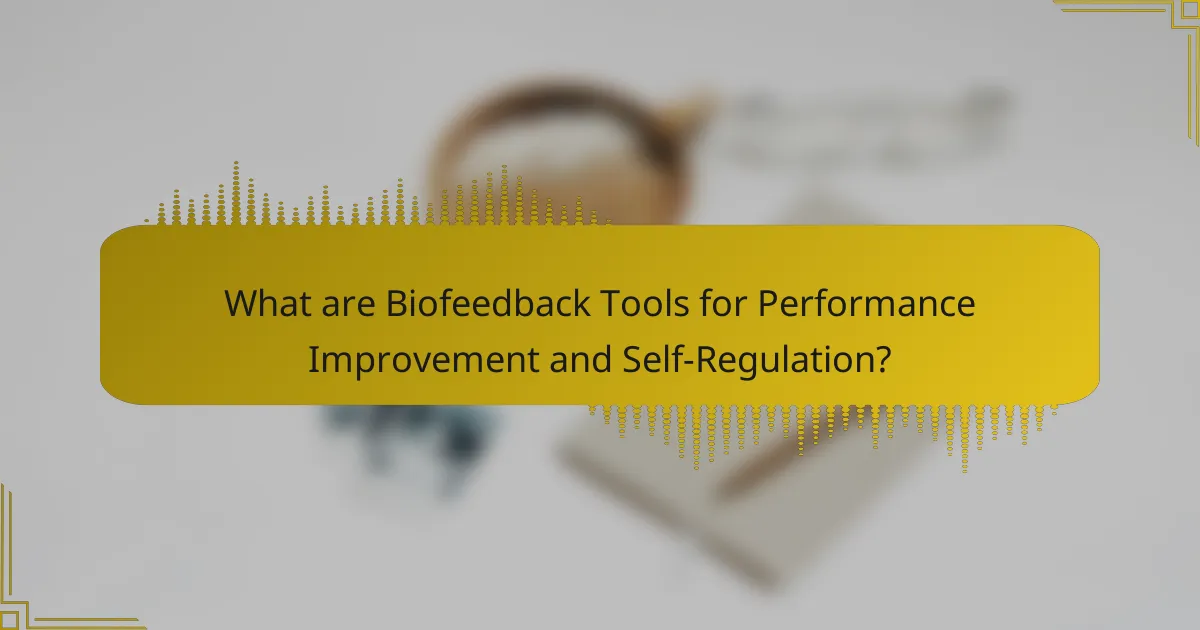Biofeedback tools enhance performance and self-regulation by providing real-time insights into physiological functions. These tools promote awareness, enabling better stress management and focus. Key types include heart rate variability monitors and neurofeedback devices. Advanced features like gamification and AI integration offer personalized experiences for improved mental and physical performance.

What are Biofeedback Tools for Performance Improvement and Self-Regulation?
Biofeedback tools enhance performance and self-regulation by providing real-time data on physiological functions. These tools help individuals learn to control bodily processes, leading to improved focus, stress management, and emotional regulation. Common types include heart rate variability monitors, electroencephalography devices, and muscle tension sensors. Each tool offers unique feedback mechanisms, enabling tailored approaches for personal growth and performance enhancement.
How do Biofeedback Tools work?
Biofeedback tools enhance performance and self-regulation by providing real-time data on physiological functions. These tools measure metrics like heart rate, muscle tension, and brain activity, allowing users to learn how to control these functions consciously.
Through visual or auditory feedback, individuals can adjust their behaviors and mental states to improve focus, reduce stress, or enhance physical performance. The unique attribute of biofeedback tools lies in their ability to promote self-awareness and self-regulation, leading to personalized strategies for optimal performance.
As a result, users can experience improved emotional regulation and resilience, making biofeedback an effective approach for enhancing overall well-being and performance.
What are the core features of Biofeedback Tools?
Biofeedback tools enhance performance and self-regulation through real-time physiological data. Core features include sensors that monitor body functions, feedback mechanisms for immediate response, and data analysis for personalized insights. These tools often utilize unique algorithms to interpret signals, providing users with actionable strategies to improve mental and physical performance. Additionally, many biofeedback devices offer mobile compatibility, allowing for convenient tracking and adjustment of training regimens.

What are the universal benefits of using Biofeedback Tools?
Biofeedback tools enhance performance and self-regulation by promoting awareness of physiological functions. They provide real-time data, enabling users to modify behaviors for better mental and physical health. Benefits include improved stress management, increased focus, and enhanced athletic performance. These tools support self-regulation by fostering a deeper connection between mind and body, allowing users to optimize their responses to stressors and improve overall well-being.
How do Biofeedback Tools enhance mental performance?
Biofeedback tools enhance mental performance by providing real-time data about physiological processes. They enable users to self-regulate stress, focus, and emotional responses, leading to improved cognitive function. For example, heart rate variability biofeedback helps individuals manage anxiety and increase concentration. Research indicates that consistent use of biofeedback can lead to measurable improvements in attention and memory retention.
What role do Biofeedback Tools play in physical performance improvement?
Biofeedback tools enhance physical performance by providing real-time data on physiological functions. These tools enable athletes to self-regulate their body responses, improving focus and reducing stress. For example, heart rate variability biofeedback helps in optimizing recovery and performance. Studies indicate that consistent use can lead to measurable improvements in endurance and strength training outcomes.

What unique attributes do specific Biofeedback Tools offer?
Biofeedback tools offer unique attributes that enhance performance improvement and self-regulation. These tools provide real-time data on physiological functions, allowing users to identify and modify their responses effectively.
One unique attribute is the ability to personalize feedback based on individual metrics, such as heart rate variability or muscle tension. This customization helps users target specific areas for improvement. Another unique feature is the integration of gamification elements, which can increase engagement and motivation during training sessions.
Additionally, some advanced biofeedback tools utilize artificial intelligence to analyze patterns over time, offering insights that can lead to more effective self-regulation strategies. This capability is rare among standard biofeedback devices, making these tools particularly valuable for serious athletes and individuals seeking to enhance their mental and physical performance.
How does Heart Rate Variability Training differ from other methods?
Heart Rate Variability Training focuses on real-time feedback to enhance autonomic nervous system regulation, unlike traditional methods that may lack this immediacy. This training promotes adaptability by teaching users to modify their physiological responses through biofeedback, which enhances performance and self-regulation. Other methods often rely on static metrics or generalized advice, missing the personalized approach that Heart Rate Variability Training offers. This unique attribute allows for tailored interventions based on individual responses, leading to more effective outcomes in performance improvement.
What makes Neurofeedback distinct in the realm of Biofeedback?
Neurofeedback is distinct in biofeedback due to its focus on brain activity regulation. Unlike other biofeedback methods that monitor bodily functions like heart rate or muscle tension, neurofeedback uses real-time data from brainwaves to promote self-regulation and cognitive enhancement. This unique attribute allows individuals to train their brain to achieve desired mental states, improving performance and emotional well-being. Studies show that neurofeedback can lead to significant improvements in attention, anxiety reduction, and overall mental clarity.

What rare attributes can be found in advanced Biofeedback Tools?
Advanced biofeedback tools may exhibit rare attributes such as real-time neurofeedback capabilities, integration with virtual reality environments, and personalized adaptive algorithms. These features enhance user experience and effectiveness in performance improvement and self-regulation. Additionally, some tools may offer multisensory feedback mechanisms that combine visual, auditory, and tactile stimuli, providing a more immersive training experience.
How do certain Biofeedback Tools integrate AI for personalized feedback?
Biofeedback tools integrate AI to provide personalized feedback by analyzing user data in real-time. These tools track physiological responses, such as heart rate and muscle tension, then apply machine learning algorithms to identify patterns. As a result, users receive tailored recommendations for performance improvement and self-regulation. Unique attributes of these AI-enhanced tools include adaptive learning capabilities, which refine feedback based on user progress. This integration enhances the effectiveness of biofeedback, making it a powerful method for achieving individual health and performance goals.
What unique data tracking capabilities do some Biofeedback devices provide?
Some biofeedback devices provide unique data tracking capabilities, such as real-time heart rate variability, muscle tension monitoring, and skin temperature changes. These features enhance performance improvement and self-regulation by offering insights into physiological responses. For example, advanced devices can analyze stress levels through electrodermal activity, allowing users to adjust their mental states effectively. Additionally, some tools offer personalized feedback based on individual performance metrics, which supports tailored training programs.

What are the best practices for using Biofeedback Tools effectively?
To use biofeedback tools effectively, establish clear goals, choose the right tool for your needs, and maintain consistent practice. Regularly review your progress and adjust techniques based on feedback. Utilize guided sessions to enhance self-regulation skills and improve performance. Engage in mindfulness practices to complement biofeedback for optimal results.
How can users optimize their experience with Biofeedback Tools?
To optimize their experience with biofeedback tools, users should focus on setting clear goals, maintaining consistent practice, and utilizing the feedback effectively. Regular engagement enhances self-regulation and performance improvement. Users can track progress through metrics provided by the tools, allowing for informed adjustments in their approach. Leveraging unique features, such as real-time data analysis, can further refine techniques for better outcomes.
What common mistakes should users avoid when implementing Biofeedback Tools?
Users should avoid common mistakes like neglecting proper calibration, overlooking user feedback, and underestimating the importance of consistent practice. Failing to set realistic goals can hinder progress. Additionally, not integrating biofeedback tools into a holistic self-regulation strategy may limit their effectiveness.
What expert insights can enhance the effectiveness of Biofeedback Tools?
Expert insights can significantly enhance the effectiveness of biofeedback tools by focusing on personalized feedback, integrating advanced technology, and emphasizing user engagement. Personalized feedback allows users to understand their physiological responses better, leading to improved self-regulation. Advanced technology, such as real-time data analytics, can provide immediate insights, enhancing the learning process. Engaging users through gamification or interactive elements can motivate consistent use, leading to better performance improvement. These insights collectively foster a more effective biofeedback experience, optimizing outcomes in self-regulation and performance enhancement.